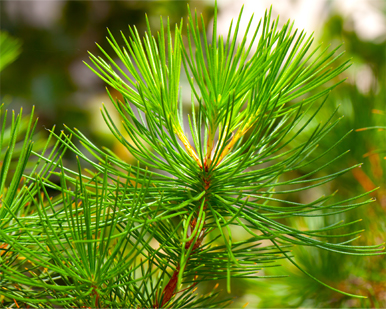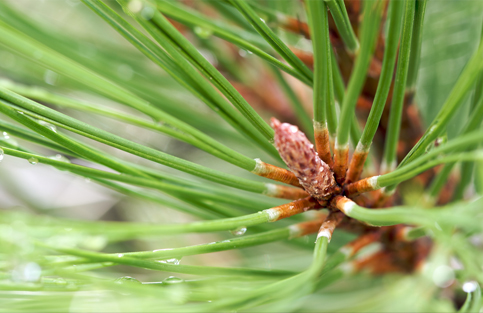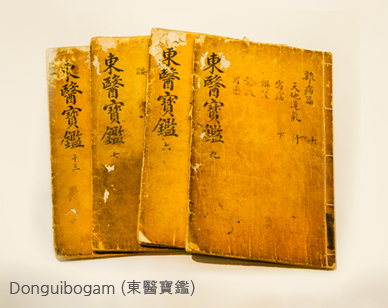![]()
About Pine Needle
Pine and pine needles
- Classification: Pine is a plant belonging to coniferales (order) Pinaceae (family).
As the tree trunk is red, it is called ‘Red pine’. As it grows mainly in the inland area, it is often called
‘Land Pine’. It is a representative tree of Korea and grows anywhere in the country. - Story: In China, pine has been said to be food for Taoist hermits. When the monk starts a fast,
he eats a handful of pine needles and goes into practice. Pine has widely been regarded as a symbol of
integrity and longevity. - Appearance of pine needle: Pine needles look like a needle and two leaves grow on the short branches
together. They twist slightly. The length is about 10cm. - Harvest: Choose shiny and dark bluish pine needles which are not easily broken nor bended when
touched. You can harvest fresh leaves, but it is better to harvest them in winter.


- Ingredients: Pine needles contain all important ingredients of pine as if pine needles are
miniature of pine. The ingredients are too many to list one by one. Let’s look at some of the major ones.- - Amino acids : All 17 kinds have been analyzed. Many essential amino acids are included.
- - Carotene : Pine needles contain 1.1 mg per 100 g, while green vegetables contain 0.6 mg
per 100g. Beta-carotene is called pro-vitamin A, because it is converted into vitamin A in the body. - - Terpene : Terpene is a volatile ingredient blown into the air and it is importantly mentioned
among ingredients of pine needles. More than 30 kinds of terpenes in pine needles have been
found by now.
It reduces cholesterol levels and increases hormone secretion by expanding the peripheral nerves.
It is effective for relief of symptoms such as hypertension or myocardial infarction occurring in
adults, as it stimulates human tissues. In addition, it helps stabilize the nerves.
- - Tannin : As it helps digestion by facilitating the stomach actions, protects gastric mucosa and relieves intestinal tension, it is very effective for those who have neurogenic
constipation. - - Glycogenin : It is called vegetable insulin. As it lowers blood sugar levels, it gives a great help to those who suffer from diabetes.
- - Rutin P : As it strengthens the capillary blood vessels, it is very effective in prevention of diseases caused by burst of blood vessels such as cerebral hemorrhage, stroke, and myoca rdial infarction. The ingredients listed above can be found in pine needles as well as other plants. However, pine needles especially have a high pharmacological value because of their unique constituents such as terpene, phenoliccompounds, vitamins and minerals.
Review on old literature: Bonchogangmok, Donguibogam
- Bonchogangmok (本草綱目): This is a study book of herbal medicines written by Lee, Shi Jin (1518-1593) of Ming Dynasty in China. It is evaluated as a pharmacy work with the greatest amounts of contents in the history of Chinese herbal medicine. It was completed in 1578 and published in 1596.
Bonchogangmok separate collection [本草綱目 別錄]
Pine Needle (松葉): It treats furunculosis caused by rheumatological disease, facilitates hair growth,
comforts five organs, does not make feel hungry and increases the life span.
(毛髮脫落, 溫疫, 瘡瘍, 風濕脚痛 )
- Donguibogam (東醫寶鑑): This is an encyclopedia of clinical medicine about Korean medicine written by Huh, Jun (1539 ~ 1615) in Joseon Dynasty. It was evaluated as the book which compiled Korean
medicine at the time. It was completed in 1610 and was published in 1613. It was listed as a UNESCO
World Heritage in 2009.
Donguibogam herbal decoction solution volume 3 Tree Part [東醫寶鑑 湯液篇卷之三 木部 ]
Pine Needle (松葉): It controls wounds caused by rheumatological disease and facilitates hair growth.
It stabilizes five organs and does not make them feel hungry. It makes them live long.
(主風.濕瘡, 生毛髮, 安五藏, 不飢, 延年)

Applications of pine needles
- Pine needle liquid: After pine needles are finely chopped, honey or sugar and soju are added and placed in a cool place for 3 ~ 4 weeks. As the pine needles
easily generate gas during this period, only 80% of the container should be filled. Once it ages, it is filtered and 1/10 of solid ingredients are added and stored. - Pine needle Tea
- - Ordinary tea: After pine needles are put in boiling water for 2 ~ 3 minutes and chopped, they are dried in the Sun for about 1 hour.
Well dried pine needles are put in the tea pot and then hot water is poured to make pine needle tea with delicate scent. - - Roasted tea: Pine needles are roasted on an oil-free frying pan and then cut them in about 1 cm with
scissors.
Once they are dried, they are the same as ordinary tea. It would be better to use hotter water than other tea.
- - Ordinary tea: After pine needles are put in boiling water for 2 ~ 3 minutes and chopped, they are dried in the Sun for about 1 hour.
- Pine needle green vegetable juice: When pine needles are used in the form of pine needle green vegetable juice, volatile ingredients cannot be dissolved.
However, you can get vitamins and other substances without modification. In the pressing process for making green vegetable juice, you can get a small amount of essential oil. - Pine needle raw food: It is effective in treatments of hypertension, paralysis and obesity, and it is excellent to be used as raw foods.
You can chew 100 young pine needles daily for 2 months. You cannot eat pine needles together with rosin.

